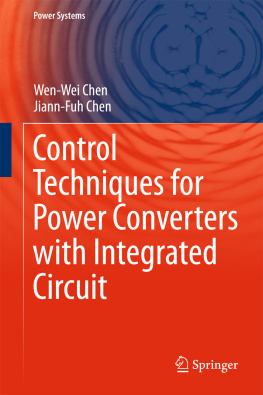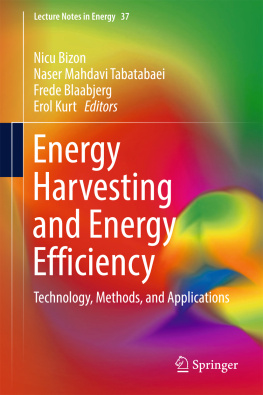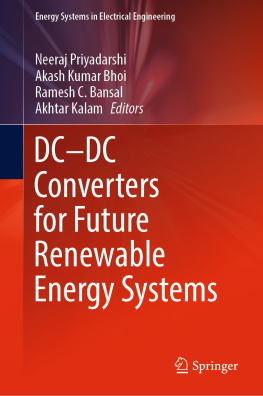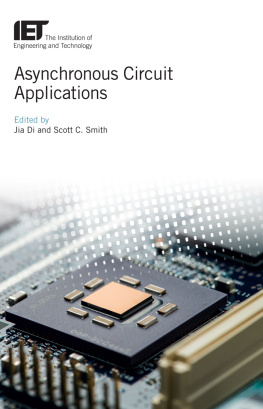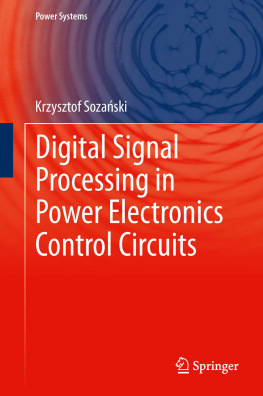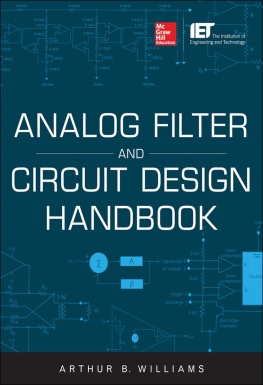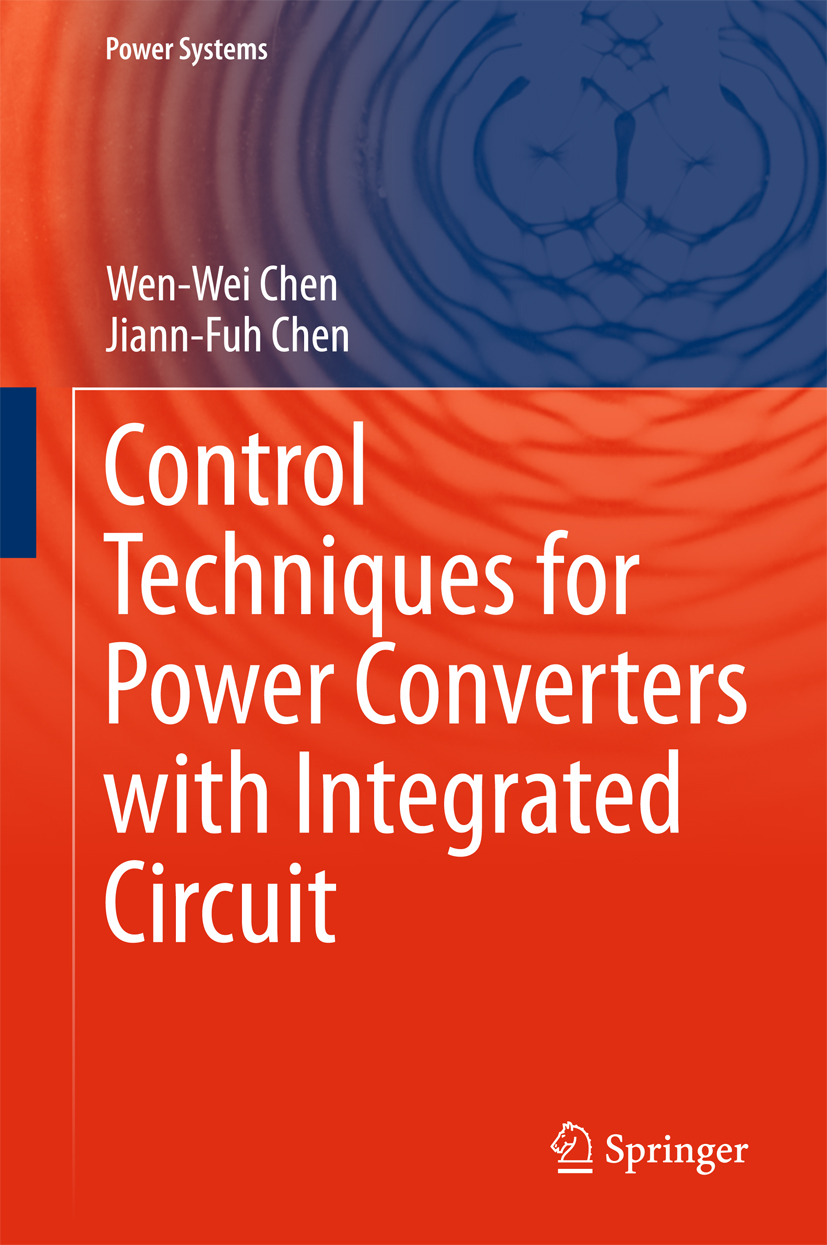Power Systems
More information about this series at http://www.springer.com/series/4622
Wen-Wei Chen and Jiann-Fuh Chen
Control Techniques for Power Converters with Integrated Circuit
Wen-Wei Chen
Department of Electrical and Computer Engineering, Virginia Tech, Blacksburg, USA
Jiann-Fuh Chen
Department of Electrical Engineering, National Cheng Kung University, Tainan, Taiwan
ISSN 1612-1287 e-ISSN 1860-4676
Power Systems
ISBN 978-981-10-7003-7 e-ISBN 978-981-10-7004-4
https://doi.org/10.1007/978-981-10-7004-4
Library of Congress Control Number: 2017955664
Springer Nature Singapore Pte Ltd. 2018
This work is subject to copyright. All rights are reserved by the Publisher, whether the whole or part of the material is concerned, specifically the rights of translation, reprinting, reuse of illustrations, recitation, broadcasting, reproduction on microfilms or in any other physical way, and transmission or information storage and retrieval, electronic adaptation, computer software, or by similar or dissimilar methodology now known or hereafter developed.
The use of general descriptive names, registered names, trademarks, service marks, etc. in this publication does not imply, even in the absence of a specific statement, that such names are exempt from the relevant protective laws and regulations and therefore free for general use.
The publisher, the authors and the editors are safe to assume that the advice and information in this book are believed to be true and accurate at the date of publication. Neither the publisher nor the authors or the editors give a warranty, express or implied, with respect to the material contained herein or for any errors or omissions that may have been made. The publisher remains neutral with regard to jurisdictional claims in published maps and institutional affiliations.
Printed on acid-free paper
This Springer imprint is published by Springer Nature
The registered company is Springer Nature Singapore Pte Ltd.
The registered company address is: 152 Beach Road, #21-01/04 Gateway East, Singapore 189721, Singapore
Contents
1. Introduction
1.1 Power Converters with Integrated Circuits
Power converter technology is basic and important because it supports and delivers all types of electronic equipment and devices, such as consumer electronics, automotive, and telecommunication []. Switching and linear power converters are characterized by small size, light weight, low cost, high reliability, and high efficiency. Mainstream technologies and trend developments are used in power converters at present. Owing to the advancement of information and rise of a communication-oriented society, trends toward personalization and mobilization have become popular, and the demand for electronic devices that are small, lightweight, inexpensive, highly reliability, and highly efficient is increasing. Power converter technology is widely used to meet output loading requirements.
DCDC power converters are utilized in portable electronic devices, such as cellular phones and laptop computers, which are primarily supplied with power by batteries or adapters. Such electronic devices often contain several sub-circuits to deliver auxiliary power, a central processing unit (CPU) voltage regulator, or a microprocessor, and the voltage level requirement of each differs from that supplied by the battery, adapter, or external power supply. In addition, battery voltage declines as its stored energy is drained. DCDC power converters increase voltage from a partially reduced battery voltage and save space compared with using multiple batteries to accomplish the same task.
Figure shows a brief circuit diagram of DCDC power converters. DCDC power converters can achieve power conversion from the input terminal to the output terminal. The input terminal of DCDC power converters is the power source, and DCDC power converters can regulate output voltage
V OUT to a specified level. Input capacitor
C IN is used to filter the input power source and is placed close to the
V IN pin of the integrated circuit (IC) on the evaluation board. This method can prevent the voltage drop of the printed circuit board (PCB) trace and ensures that the input voltage possesses good noise immunity. Output capacitor
C O is used to filter the output voltage and provide output capacitor
C O energy, thereby preventing output voltage
V OUT from dropping significantly at the load transient. Output capacitor
C O is placed close to the
V OUT or
V FB pin of IC on the evaluation board. This method can prevent the voltage drop of the PCB trace from affecting feedback voltage
V FB and ensures that feedback voltage
V FB possesses good noise immunity.
Fig. 1.1
A brief circuit diagram of DCDC power converters
Power ICs are self-contained circuits with many separate components, such as transistors, diodes, resistors, and capacitors, fabricated into a single tiny chip of a semiconductor material []. ICs are extremely small; they are thousands of times smaller than discrete circuits. ICs are also lightweight because of the miniaturized circuits and inexpensive because of the simultaneous production of hundreds of similar circuits on a small semiconductor wafer. An IC costs as much as an individual transistor because ICs are mass produced. ICs are highly reliable because of the absence of soldered joints and the need for only a few interconnections. ICs are widely used in DCDC power converters because of their advantages.
DCDC power converters with ICs are widely utilized in different industries, such as consumer electronics, automotive, telecommunication, networking, and medical. The various types of power ICs used at present include voltage regulators, battery management ICs, integrated application-specific standard product (ASSP) power ICs, and motor control ICs. Technological advancements and the increasing demand for battery-operated devices are the major factors that drive the market at present. The market is expected to grow because the demand for consumer electronics and automobiles is expected to increase in the future.
DCDC power converters can be classified as step-down and step-up converters according to the difference between input and output voltages. A power converter whose input voltage V IN is larger than output voltage V

